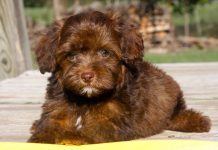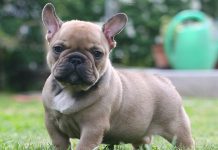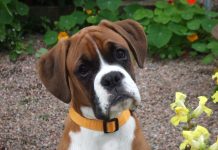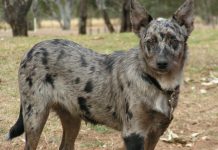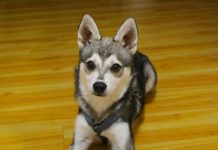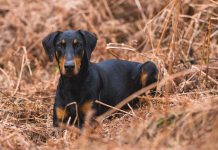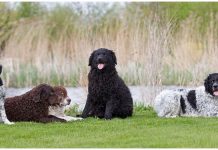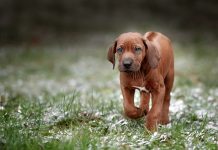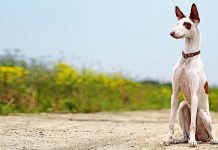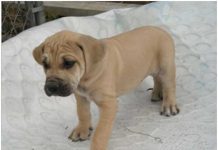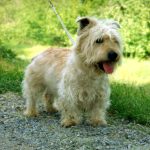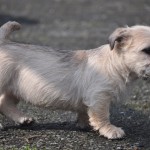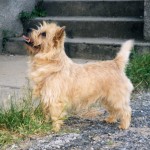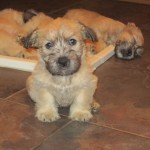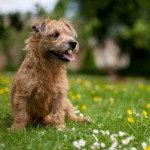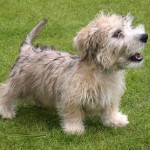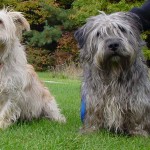Perhaps the greatest reason to get a Glen of Imaal Terrier is that they are observant watchdogs, yet are polite and friendly.
History and Health :
- History :
The most authoritative reports of the origin of these dogs state that during civil unrest, mercenaries hired to put down the unrest, came back and settled in the Wicklow area with hounds to breed with the local terriers. The descendents came to be known as the Glen of Imaal Terrier and were used to rid the area of vermin such as fox, badger, otter and rats.
- Health :
They are generally more strong and healthy than other breeds. In fact, cardiac problems are virtually nonexistent. They may have some skin allergies but that may be due to diet or the common problems of fleas, affecting many pets. More pertinently, because of their dwarfism, they have a unique structure which makes them susceptible to injuries that can affect the further development of their front legs. They must not be allowed to jump off of chairs, beds or sofas until they are at least one year old, at which time they are stronger.
Temperament and Personality :
- Personality :
They tend to be energetic, tenacious, more even-tempered and less vocal than other small terriers, love activity yet are equally content to relax with their caretakers, intelligent, stubborn, fearless and loyal.
- Activity Requirements :
Glennies need not only to play but also to be taken for a daily walk. They need to walk beside or behind the person providing the walk, as this will indicate to the dog that the human is the leader. If they are not given a daily walk then they can develop behavioral problems. They should also be allowed to frolic in a large, fenced-in yard.
- Trainability :
They are perhaps average in terms of trainability and, as such, may need the assistance of a professional. When this is done, then it usually results in the “Glen sit”, the famous pose in which the dog sits on its hind legs and holds its back erect. This ability is usually not accomplished in other breeds.
- Behavioral Traits :
The need for exercise is both a boon and a bane because, even though it can be enjoyable and healthy for the dog, it may be difficult to find the time to provide him with as much as he wants. They also tend to be aggressive toward other animals (as a result of its chasing instincts); to dig holes (if given the opportunity) and to bark a lot.
Appearance & Grooming :
- Appearance :
They are considered to be a dwarf breed and thus have a relatively large head in relation to its body. Their bodies tend to be sturdy but their feet are turned out. The fur is medium in length and is soft underneath.
- Size and Weight :
Given the fact that they are dwarves, they are not tiny and usually grow to 14 inches (35 cm) in height and are usually at or about 35 lbs (15.9 kg).
- Coat and Color :
The texture of the fur can appear rough but the undercoat is most definitely soft. The color is of blue, brindle, or wheaten with all shades from cream to red wheat.
- Grooming :
Even though the coat can appear to be rough, it is very easy to groom these dogs. The fur on the tail can become long and should be cut when needed. They also grow hair in their ears and between the pads of their feet, all of which should be removed. They do not shed much hair.
- Body Type :
Their bodies tend to be more long than high, with strong loins, and a broad and strong chest.
Characteristics :
- They are average in terms of dealing with children.
- They most definitely are not good with cats.
- They tend to be antagonistic toward other dogs, as well.
- Glen of Imaal Terriers are average in terms of trainability.
- There is contradictory information regarding shedding. One authoritative source says that there is little shedding of fur, while another ranks it poor in the amount of fur shed.
- Perhaps because of their innate antagonism toward cats, dogs and other creatures they are considered excellent watchdogs.
- They are considered to be higher than average in intelligence among all dogs.
- Because of hair, and long hair, where it should not be grooming can be an extra nuisance.
- Especially in the United States, they are extremely rare so have become not so popular as many other breeds are available.
- They are considered to be very adaptable.
- Although they do not (or perhaps do) shed, they are not considered to be hypoallergenic, perhaps because of the longer and rougher fur.
Tasty Tidbits :
They suffer from many of the same complaints of other terriers, and have the unique and innate desire to dig holes.
Care :
Other than what has already been mentioned, they are remarkably healthy and long-living as a result.
Feeding :
After becoming one year old, the best diet for them is one of lower protein.
Photos, Images, Pics, and Pictures of Glen of Imaal Terrier :
Information and Facts of Glen of Imaal Terrier :
- This breed’s name is Glen of Imaal Terrier.
- It also goes by the names of Irish Glen of Imaal Terrier, Wicklow Terrier, or simply Glen or even Glennie.
- Perhaps, or perhaps not, contradictory to its name, this breed is of unknown origins although the name came to exist in the Glen (or Valley) of Imaal in County Wicklow in Ireland during the reign of Queen Elizabeth I.
- It is a small dog, usually no more than 14 inches (35 cm) in height.
- Its breed group is terrier.
- They are generally very healthy and, as a result, often live to be 15 years or more.
- They are almost always between the heights of 12 to 14 inches (30 to 35 cm).
- For their short stature, some of them can be quite hefty and weigh anywhere from 32 to 45 lbs (14.5 to 20.4 kg).
- They come in a variety of colors and hues but they are generally described as being wheaten, blue or brindle colored.
- In the United States, these dogs are rare. In fact, the breed almost died out but was revived in the early 20th century. Needless to say, there is no information on the price of such puppies.
- They are active and sleep for a normal period of time.
- Because of its relatively old origins, it does not seem to have any nearby relatives, and is therefore somewhat unique, other than it being a part of the Terrier group. Some people associate Glen of Imaal Terriers with the Dandie Dinmont Terrier of Scotland, but there is little evidence of an actual relationship.
Also Read: Norrbottenspets



